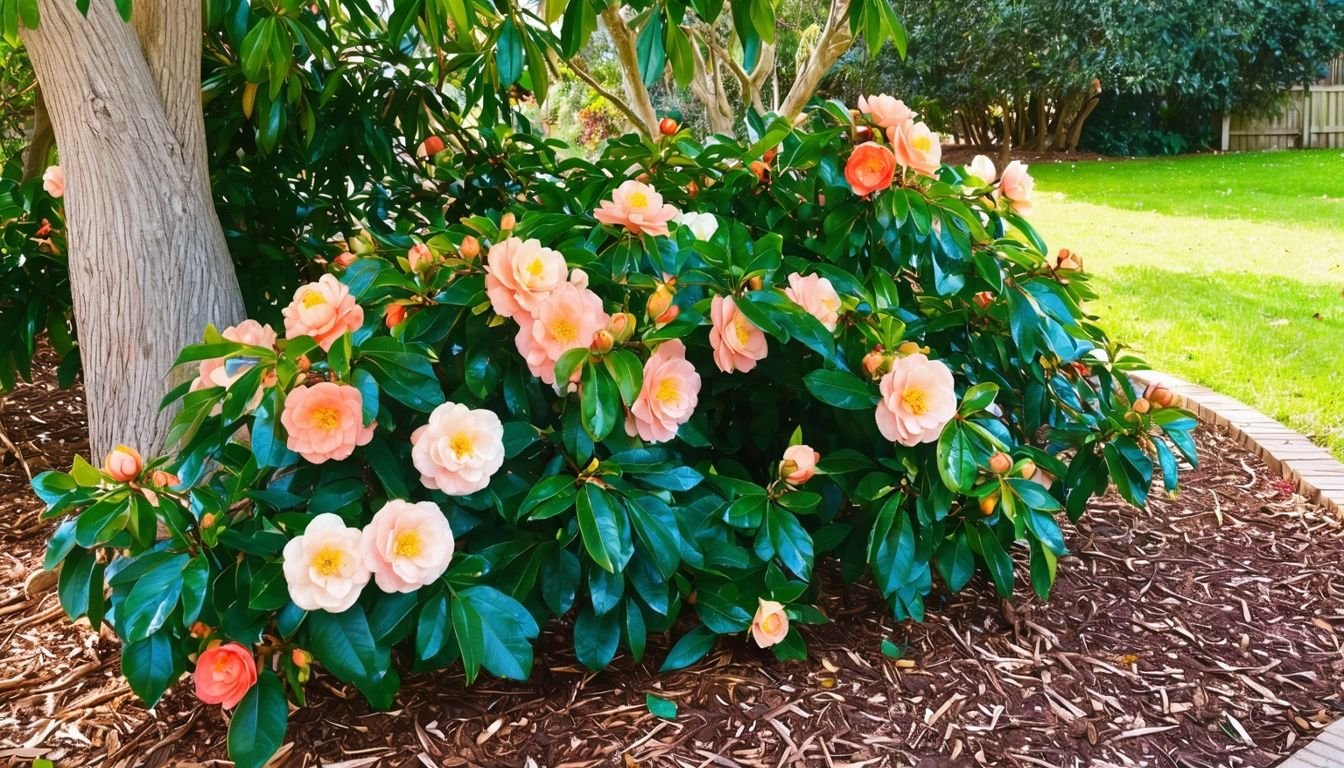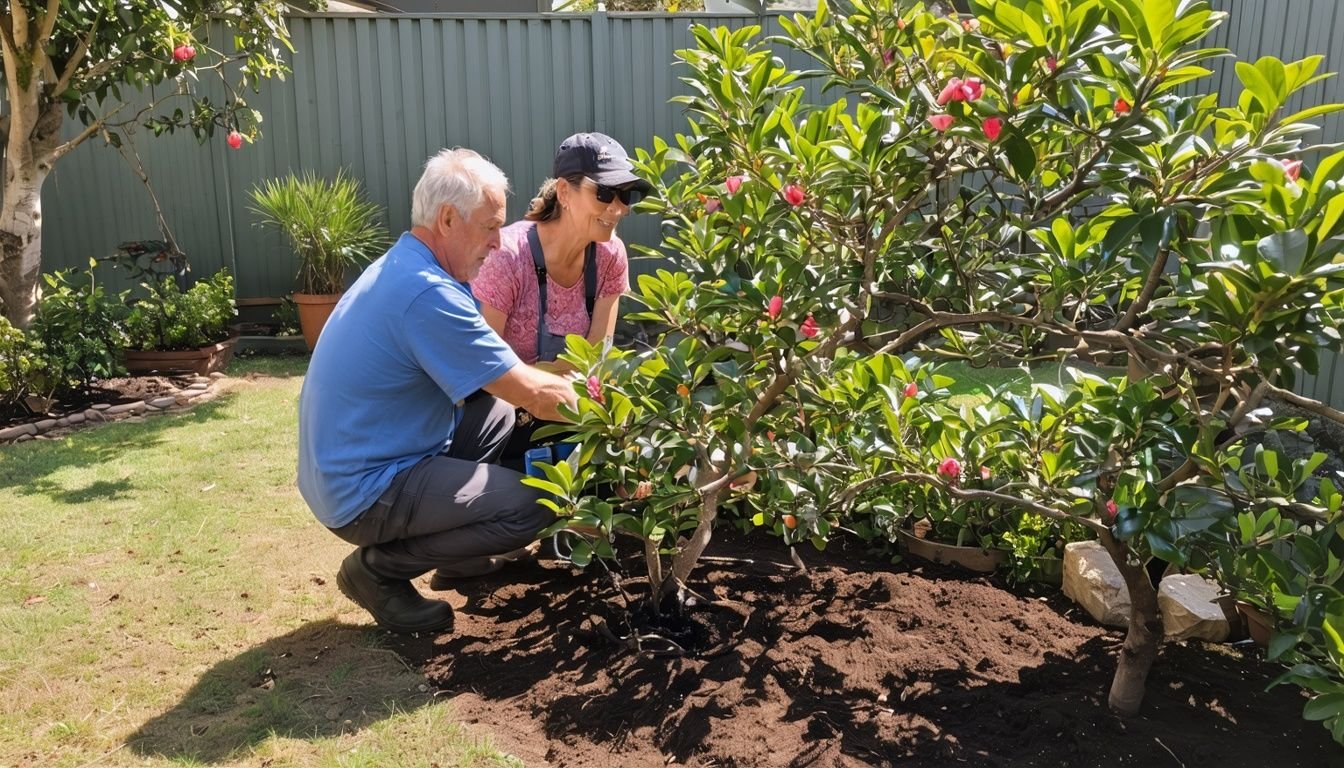Growing Camellia Japonica Elegans Champagne can be a real headache for Aussie gardeners. This stunner, with its creamy centre and wavy outer petals, often chucks a wobbly in our harsh climate.
Many green thumbs end up tearing their hair out when their camellias fail to thrive or produce those jaw-dropping blooms they’ve been dreaming of.
We’ve been there, mate. After years of mucking about in our own backyards, we’ve cottoned on to the fact that Camellia Japonica Elegans Champagne has actually been kicking around for about 300 years.
We’ve done our homework and put in the hard yards to suss out the best ways to grow this elegant plant in true blue Aussie conditions. Our guide will walk you through the nuts and bolts of successful camellia cultivation, from picking the right potting mix to nailing those pruning techniques.
So roll up your sleeves and get ready to give your garden a fair dinkum makeover with these gorgeous blooms.
Key Takeaways
- Camellia Japonica Elegans Champagne needs acidic soil with a pH of 5.5 to 6.5 and partial shade to thrive in Aussie gardens.
- Water your camellia deeply once or twice a week, and use a slow-release, acid-forming fertiliser in spring after flowering.
- Prune lightly in spring to shape the plant, and do a bigger prune after flowering to remove spent blooms and weak branches.
- Keep an eye out for pests and diseases by checking your plant weekly, and use neem oil or insecticidal soap for common bugs.
- With proper care, this 300-year-old camellia variety will reward you with stunning cream-centred blooms year after year.
Optimal Planting Conditions
 Camellia japonica ‘Elegans Champagne’ thrives in well-draining, acidic soil rich in organic matter. These stunning ornamentals prefer partial shade, especially protection from harsh afternoon sun in Australian gardens.
Camellia japonica ‘Elegans Champagne’ thrives in well-draining, acidic soil rich in organic matter. These stunning ornamentals prefer partial shade, especially protection from harsh afternoon sun in Australian gardens.
Soil requirements
We’ve found that Camellia japonica ‘Elegans Champagne’ thrives in acidic soil with a pH between 5.5 and 6.5. This stunning ornamental plant prefers well-drained soil rich in organic matter.
We recommend mixing topsoil with peat moss or composted pine bark to create the ideal growing medium. This combination ensures proper drainage while retaining enough moisture for healthy root development.
For best results, we prepare the planting area by digging a hole twice the size of the root ball and incorporating plenty of organic material. A special potting mix designed for acid-loving plants works well too.
We avoid using alkaline materials like lime or wood ash near camellias, as these can raise soil pH and lead to nutrient deficiencies. Regular soil testing helps us maintain the right acidity levels for these beautiful cream-centred blooms.
Proper soil preparation sets the stage for healthy growth and abundant flowering. Next, let’s explore the sunlight and shading needs of Camellia japonica ‘Elegans Champagne’.
Sunlight and shading needs
Building on our discussion of soil requirements, let’s explore the crucial aspect of sunlight and shade for Camellia Japonica Elegans Champagne. These elegant shrubs thrive in specific light conditions, which play a vital role in their growth and blooming.
Our Camellia Japonica Elegans Champagne plants prefer a balance of light and shade. They flourish in morning sun to part shade, making them ideal for east-facing gardens or areas with dappled sunlight.
Dense shade can limit flower production, so we aim for a spot that offers some filtered light throughout the day. Protection from harsh afternoon sun is essential, as it can scorch the leaves and damage the plant.
Camellia Japonica Elegans Champagne: Nature’s delicate balance of sun and shade.
We’ve found that planting these camellias near deciduous trees or structures that provide afternoon shade works well. This setup mimics their natural habitat and supports healthy growth.
In warmer Australian regions, extra care to shield them from intense sunlight becomes even more critical. By carefully considering light exposure, we can create the perfect environment for our Camellia Japonica Elegans Champagne to thrive and showcase its stunning cream-centred blooms.
Maintenance and Care
Keeping your Camellia Japonica Elegans Champagne healthy requires regular care. We’ll guide you through essential pruning techniques and proper watering practices to ensure your plant thrives in your Australian garden.
Pruning strategies
We love helping our Camellia Japonica Elegans Champagne thrive in Australian gardens. Our pruning strategies keep these beauties healthy and shapely, enhancing their cream centres and overall appearance.
- Light pruning in spring: We trim the tips of branches to shape the plant and encourage bushier growth. This technique works well for creating a hedge or maintaining a compact form.
- Post-flowering pruning: After the blooms fade, we remove spent flowers and any weak or crossing branches. This practice improves air circulation and redirects energy to new growth.
- Thinning out: We selectively remove some inner branches to allow more light and air into the centre of the plant. This method helps prevent fungal issues and promotes better flowering.
- Rejuvenation pruning: For older plants, we cut back hard to about 60 cm from the ground. This drastic measure stimulates new growth and revitalises the plant over time.
- Pruning for size control: We trim the outer branches to maintain the desired size and shape. This technique is especially useful for camellias grown in containers or small spaces.
- Dead wood removal: We regularly inspect our camellias and remove any dead, diseased, or damaged wood. This practice keeps the plant healthy and prevents potential pest infestations.
Watering and feeding practices
Proper watering and feeding are crucial for the health of your Camellia Japonica Elegans Champagne. We’ll guide you through the best practices to keep your camellia thriving in your Australian garden.
- Consistent moisture: Keep the soil moist but not waterlogged. Water deeply once or twice a week, especially during dry spells and summer months.
- Mulching: Apply a 5-7 cm layer of organic mulch around the base of the plant. This helps retain moisture and regulate soil temperature.
- Avoid overhead watering: Water at the base of the plant to prevent leaf spotting and fungal diseases.
- Morning watering: Water early in the day to allow foliage to dry before nightfall, reducing the risk of disease.
- Fertiliser application: Feed your camellia with a slow-release, acid-forming fertiliser in spring after flowering.
- pH balance: Maintain slightly acidic soil (pH 5.5-6.5) for optimal nutrient uptake. Use a pH test kit to monitor levels.
- Foliar feeding: Supplement with occasional foliar sprays of seaweed or fish emulsion during the growing season.
- Water quality: Use rainwater or filtered water if possible, as camellias are sensitive to chlorine and fluoride in tap water.
- Winter care: Reduce watering in winter, but don’t let the soil dry out completely.
- Compost tea: Brew and apply compost tea monthly to boost soil health and plant immunity.
Now that we’ve covered watering and feeding, let’s move on to common pests and diseases that might affect your Camellia Japonica Elegans Champagne.
Common Pests and Diseases
Camellia Japonica Elegans Champagne faces threats from various pests and diseases. We’ll explore effective prevention methods and treatment options to keep your plants healthy and thriving.
Prevention and treatment options
Camellia japonica Elegans Champagne is a stunning variety that can enhance any Australian garden. We’ve compiled essential prevention and treatment options to help you maintain the health of this beautiful plant:
- Regular inspection: Check your camellia weekly for signs of pests or diseases. Early detection is crucial for effective treatment.
- Proper watering: Maintain consistent moisture without overwatering. Use drip irrigation or soaker hoses to keep water off the leaves, reducing fungal growth risks.
- Good air circulation: Prune after flowering to improve air flow around the plant. This helps prevent fungal issues common in humid conditions.
- Mulching: Apply a 5-7 cm layer of organic mulch around the base, keeping it away from the trunk. This conserves moisture and suppresses weeds that can harbour pests.
- Balanced fertilisation: Feed with a camellia-specific or slow-release fertiliser in spring. Avoid over-fertilising, which can lead to weak growth susceptible to pests and diseases.
- Pest control: Use neem oil or insecticidal soap for common pests like scale insects or spider mites. Apply these treatments in the evening to avoid leaf burn.
- Disease management: For fungal issues like petal blight, remove and destroy affected flowers promptly. Apply a fungicide if the problem persists.
- Winter protection: In colder regions, cover young plants with frost cloth during severe cold snaps to prevent damage.
- Soil pH maintenance: Test soil pH annually and adjust if needed. Camellias prefer slightly acidic soil (pH 5.5-6.5), which helps prevent nutrient deficiencies.
- Companion planting: Grow lavenders or mint nearby to attract pollinators and beneficial insects that can help control pest populations naturally.
Conclusion
Cultivating Camellia Japonica Elegans Champagne brings beauty and elegance to Australian gardens. We’ve explored essential care techniques, from soil preparation to pest management.
With proper attention and love, this stunning shrub will thrive in your outdoor space. Remember to water regularly during hot spells and protect it from harsh afternoon sun. Your efforts will reward you with lush foliage and breathtaking blooms year after year.
FAQs
1. How often should I water my Camellia Japonica Elegans Champagne?
Water your Camellia regularly, like you would citrus trees. Keep the soil moist but not waterlogged. Avoid overwatering, which can lead to low oxygen levels in the roots.
2. Can I grow Camellia Japonica Elegans Champagne as an indoor plant?
While Camellias prefer outdoor gardens, you can grow them indoors. Treat them like other indoor plants. Ensure they get enough light and maintain proper humidity.
3. What type of soil is best for Camellia Japonica Elegans Champagne?
Use well-draining soil similar to what you’d use for lavandula or olives. Add organic matter to improve soil quality. This helps prevent water-logging and promotes healthy growth.
4. How do I protect my Camellia from extreme Australian weather?
Plant your Camellia in a sheltered spot, away from harsh winds. Consider using a click & collect service for protective materials during extreme weather events.
5. Can I plant Camellia Japonica Elegans Champagne near a eucalyptus tree?
It’s best to avoid planting Camellias near eucalyptus trees. Eucalyptus can compete for water and nutrients. Choose a location where your Camellia can thrive without competition.
